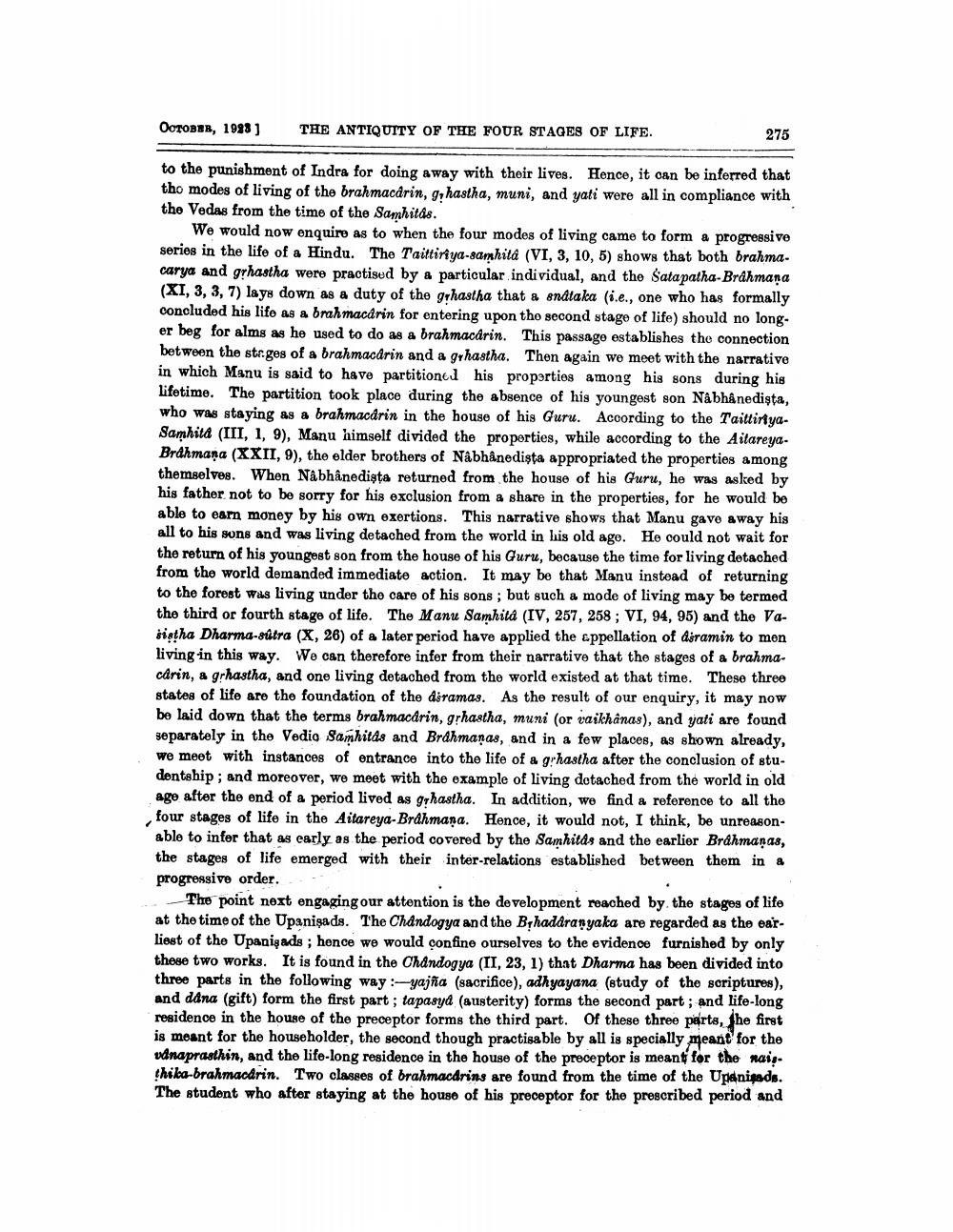________________
OCTOBER, 1998)
THE ANTIQUITY OF THE FOUR STAGES OF LIFE.
275
to the punishment of Indra for doing away with their lives. Hence, it can be inferred that tho modes of living of the brahmacdrin, g, hastha, muni, and yati were all in compliance with the Vedas from the time of the Samhitas.
We would now enquire as to when the four modes of living came to form a progressive series in the life of a Hindu. The Taittiriya-samhita (VI, 3, 10, 5) shows that both brahmacarya and grhastha were practisud by a particular individual, and the Satapatha-Brahmana (XI, 3, 3, 7) lays down as a duty of the grhastha that a anataka (i.e., one who has formally concluded his life as a brahmacarin for entering upon the second stage of life) should no longer beg for alms as he used to do as a brahmacárin. This passage establishes the connection between the str.ges of a brahmacârin and a grhastha. Then again we meet with the narrative in which Manu is said to have partitioned his properties among his sons during his lifetime. The partition took place during the absence of his youngest son Nâbhânedista, who was staying as a brahmacarin in the house of his Guru. According to the TaittiriyaSamhita (III, 1, 9), Manu himself divided the properties, while according to the AitareyaBrdhmana (XXII, 9), the elder brothers of Nâbhânedista appropriated the properties among themselves. When Nâbhânedista returned from the house of his Guru, he was asked by his father not to be sorry for his exclusion from a share in the properties, for he would be able to earn money by his own exertions. This narrative shows that Manu gave away his all to his sons and was living detached from the world in his old age. He could not wait for the return of his youngest son from the house of his Guru, because the time for living detached from the world demanded immediate action. It may be that Manu instead of returning to the forest was living under the care of his sons; but such a mode of living may be termod the third or fourth stage of life. The Manu Samhita (IV, 257, 258 ; VI, 94, 95) and the Vasistha Dharma-sútra (X, 26) of a later period have applied the cppellation of asramin to mon living in this way. We can therefore infer from their narrative that the stages of a brahmacarin, a grhastha, and one living detached from the world existed at that time. These three states of life are the foundation of the dsramas. As the result of our enquiry, it may now be laid down that the terms brahmacdrin, grhastha, muni (or vaikhanas), and yati are found separately in the Vedio Samhitas and Brahmanas, and in a few places, as shown already, we meet with instances of entrance into the life of a grhastha after the conclusion of studentship, and moreover, we meet with the example of living detached from the world in old age after the end of a period lived as grhastha. In addition, we find a reference to all the four stages of life in the Aitareya-Brahmana. Hence, it would not, I think, be unreasonable to infer that as early as the period covered by the Samhitas and the earlier Brāhmaṇas, the stages of life emerged with their inter-relations established between them in a progressive order.
The point next engaging our attention is the development reached by the stages of life at the time of the Upanişads. The Chandogya and the Brhadaranyaka are regarded as the earliest of the Upanigads; hence we would confine ourselves to the evidence furnished by only these two works. It is found in the Chandogya (II, 23, 1) that Dharma has been divided into three parts in the following way :-yajña (sacrifice), adhyayana (study of the scriptures), and dana (gift) form the first part ; tapasyd (austerity) forms the second part ; and life-long residence in the house of the preceptor forms the third part. Of these three parts, the first is meant for the householder, the second though practisable by all is specially meant for the udnaprasthin, and the life-long residence in the house of the preceptor is meant for the nais. thika-brahmacdrin. Two classes of brahmacarins are found from the time of the Upanipads. The student who after staying at the house of his preceptor for the prescribed period and




